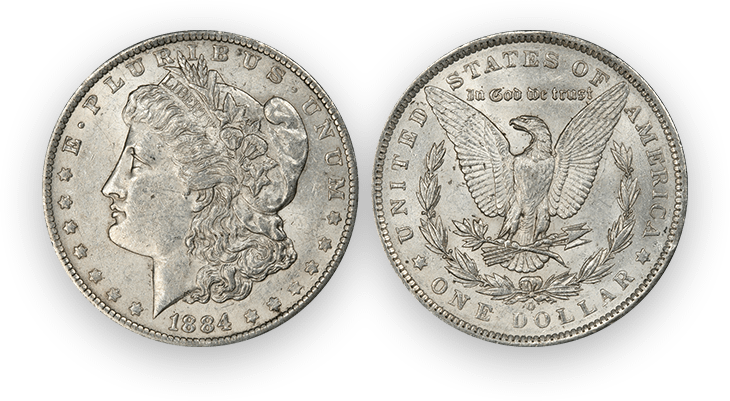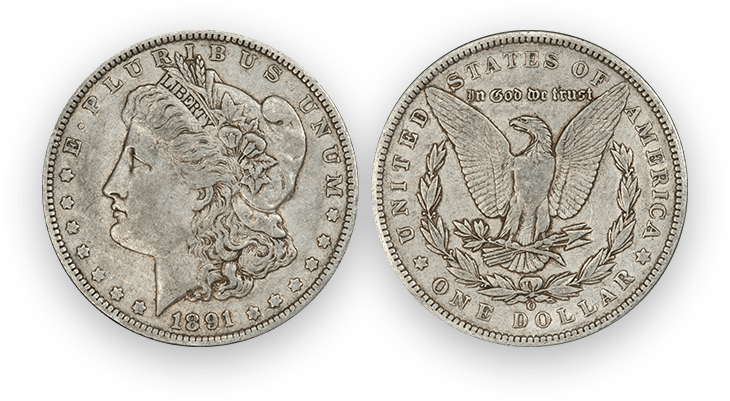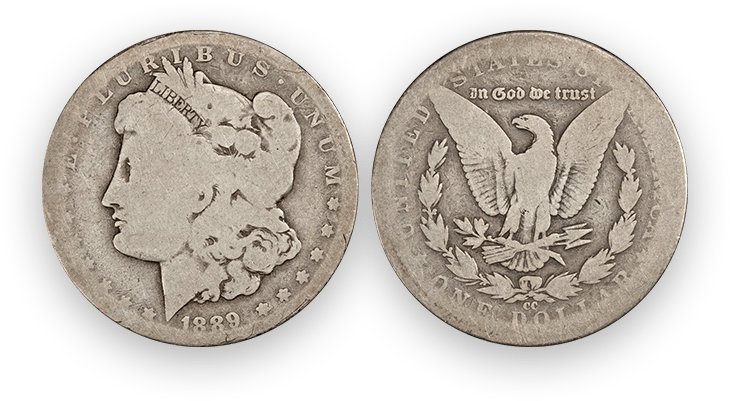The Sheldon Scale – Grade by Grade
PO-1 – Poor

Nearly all of a coin’s details have been worn flat in the grade of Poor. Enough detail exists to identify the date, the type of coin, and sometimes the mintmark.
FR-2 – Fair

In Fair, additional detail is apparent, but most of the design is worn flat. The rims are worn flat.
AG-3 – About Good

Main features are outlined, but no hair or feather details will be evident. The rim is worn, and the legends can be partially visible. LIBERTY will be at least partially visible.
G-4 – Good (4)

Good coins have legible dates and inscriptions and reveal only the outline of the other devices. Some details may be visible.
G-6 – Choice Good

Good-6, being slightly better than Good-4, reveals mostly flattened devices with some remnants of visible detail.
VG-8 – Very Good

A Very Good-8 coin is better than Good but not quite Fine. These coins exhibit complete inscriptions and some details on the devices. About half of the secondary detail is worn off.
VG-10 – Choice Very Good

In Very Good-10, hair and face detail may be partially visible. The rims are full, and the inscriptions are complete.
F-12 – Fine

In Fine-12, half of the coin’s detail should be visible. For example, the visible detail on the Liberty Seated type (pictured above) will typically be on the gown and the eagle’s feathers. All lettering will be visible.
F-15 – Choice Fine

In Very Fine-15, more than half but less than 2/3 of the design details will be visible. All inscriptions will be clearly visible and sharp.
VF-20 – Very Fine

About 2/3 of the detail is visible on the coin at Very Fine-20. Inscriptions will be visible and sharp. On a coin like the Buffalo Nickel, with its thin inscriptions, some distortion on the letters is expected. The buffalo’s horn will usually be visible.
VF-25 – Very Fine (25)

In Very Fine-25, the hair will be worn, but more than 2/3 of the details will be visible. Wear will be apparent throughout the coin, but key details are easily identifiable.
VF-30 – Choice Very Fine

Even worn throughout, with more than 2/3 of the details visible. What differentiates Very Fine-30 from Very Fine-25 is the overall eye appeal of the coin, given its circulated state.
VF-35 – Choice Very Fine (35)

In Very Fine-35, most of the design detail will be visible, although the high points will show even wear throughout. Rims, denticles, and inscriptions will be sharp.
EF-40 – Extra Fine

Light wear will be present throughout on coins graded Extra Fine-40. Typically, this wear will be on the high points of the relief, like the center of the eagle’s breast in the image above. Light wear on the wreath will be present, and some finer details may be worn.
EF-45 – Choice Extra Fine

In Extra Fine-45, light wear is visible on the highest points of the relief. Other design details will be clearly defined. Coins may have dull surfaces or appear slightly “dirty†from use.
AU-50 – About Uncirculated

An AU50 coin will be missing between 50% and 100% of its original mint luster. Most of the coin’s details will remain, but wear will be obvious to the naked eye.
AU-53 – About Uncirculated (53)

Light wear on the coin’s highest spots and luster disturbances cover most of the coin.
AU-55 – Choice About Uncirculated

Light wear will be present on the coin’s highest spots, but most of the coin’s luster is intact.
AU-58 – Choice About Uncirculated (58)

A coin showing only the slightest evidence of wear, typically on areas of highest relief. The coin will have 90% of its luster intact and may appear uncirculated except under certain lighting conditions.
MS-60 – Typical Mint State

A coin in Mint State-60 is strictly uncirculated with no signs of wear. Heavy marks will be present on the coin due to incidental contact with other coins after production. Occasionally coins graded MS60 will show signs of an old cleaning that falls within market acceptable tolerances. It is not unusual for a coin graded AU58 to have better eye appeal than a coin graded MS60.
MS-61 – Typical Mint State

A coin graded MS61 will have numerous marks. In addition to marks, graders look for hairlines and other signs of an old cleaning, as long as these fall within market-acceptable tolerances. The strike quality of the coin at this level is often weak, with poor luster and below-average eye appeal.
MS-62 – Typical Mint State

Hits and hairlines will be visible on coins graded MS62. For larger coins, these hits may appear in focal areas. The strike can be weak to full as can the luster. In MS62, some issues, be it hits or weaknesses of luster, inform the grade.
MS-63 – Choice Mint State

Numerous small marks will be present on coins graded MS63. This grade is considered Choice Mint State and a step up from the typical Mint State coins of MS60 to MS62. The fields on MS63 coins will be relatively clean, and in many cases, MS63 coins can have attractive qualities that are impaired only by some minor issues.
MS-64 – Choice Mint State

This in-between grade was conceived as way to split the difference between MS63 (Choice) and MS65 (Gem). A few minor issues, or one or two significant ones, may be present. Eye appeal will usually be good, and the surfaces will exhibit minimal hairlines.
MS-65 – Gem Mint State

When the third-party grading services began operation in the mid-1980s, the grade MS65 was more highly regarded than it is today. The first of the Gem grades, coins in MS65 will exhibit only slight defects and an occasional scattered mark, though generally not in focal areas. Gems should be well-struck coins with average or better luster. Spotting is permitted on copper coins, as long as it is minor.
MS-66 – Gem Mint State

Defects will be minimal on coins graded MS66. In the image above, a small tick is visible behind Liberty’s eye, and another minor hit is apparent near the top of the first three feathers. The coin is clean of defects elsewhere, save a scattered copper spot here or there. MS66 coins will have above average or better eye appeal.
MS-67 – Superb Gem Mint State

MS67 is considered a superior uncirculated grade with minimal marks or distracting features. Any hits at this grade will be very light and hidden. In the case of larger coins, these flaws may be present in the unprotected areas of the field. In some instances, one of two hits in a focal area on an otherwise pristine coin may permit a coin to be graded MS67.
MS-68 – Superb Gem Mint State

MS68 coins are typically free of distracting imperfections or flaws, except for modern commemorative or bullion coins, which may look poor because their surfaces are typically flawless. The strike will be sharp and the coin will have superior eye appeal.
MS-69 – Near-Perfect Mint State

A coin graded MS69 will be nearly perfect with only the slightest flaws. These flaws may only be visible under magnification. In the case of a large coin, like the American Silver Eagle, some MS69 coins will appear to the untrained numismatist to be virtually indistinguishable from MS70 coins.
MS-70 – “Perfect†Mint State

Coins graded MS70 is perfect as struck and will exhibit no flaws, or Mint-made defects under magnification up to five times. Typically only seen on ultra-modern coins, bullion coins, and commemorative issues.
Strike Types
Mint State (MS)
The numerical grades MS-60 through MS-70, used to denote a business strike coin that never has been in circulation. A Mint State coin can range from one that is covered with marks (MS-60) to a flawless example (MS-70).
Proof (PR)
A coin usually struck from a specially prepared coin die on a specially prepared planchet. Proofs are usually given more than one blow from the dies and are usually struck with presses operating at slower speeds and higher striking pressure. Because of this extra care, Proofs usually exhibit much sharper detail than regular, or business, strikes. PCGS recognizes Proofs (PR) as those struck in 1817 and later.
Specimen (SP)
Special coins struck at the Mint from 1792-1816 that display many characteristics of the later Proof coinage. Prior to 1817, the minting equipment and technology was limited, so these coins do not have the “watery” surfaces of later Proofs nor the evenness of strike of the close collar Proofs.
MS/PR-70

View Details
MS/PR-69

View Details
MS/PR-68

View Details
MS/PR-67

View Details
MS/PR-66

View Details
MS/PR-65

View Details
MS/PR-64

View Details
MS/PR-63

View Details
MS/PR-62

View Details
MS/PR-61

View Details
MS/PR-60

View Details
AU-58

View Details
AU-55

View Details
AU-53

View Details
AU-50

View Details
XF-45

View Details
XF-40

View Details
VF-35

View Details
VF-30

View Details
VF-25

View Details
VF-20

View Details
F-15

View Details
F-12

View Details
VG-10

View Details
VG-8

View Details
G-6

View Details
G-4

View Details
AG-03

View Details
FR-2

View Details
PO-1

View Details
UNGRADABLE

View Details
Plus Grades
“Plus Grades” exhibit exceptional eye appeal for the grade and constitute the top 30% of the coins in the grade.Only XF-45 through MS/PR-68 are eligible for Plus grades. Numerically, this includes 45, 50, 53, 55, 58, 62, 63, 64, 65, 66, 67, & 68.

